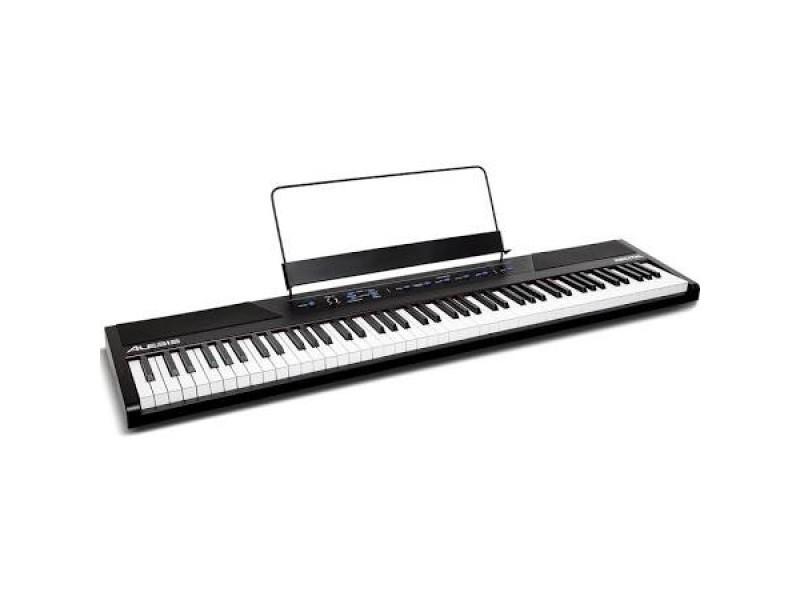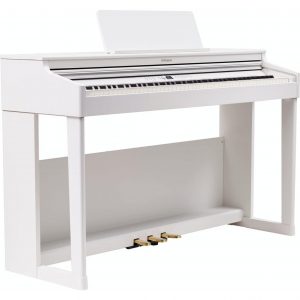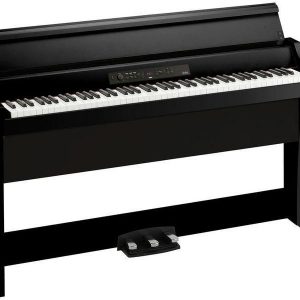Alesis Recital
$155.99
Experience exceptional sound quality and an authentic piano playing experience with the Alesis Recital piano – perfect for beginners and advanced pianists alike!
Compare
Description
Alesis Recital Piano: An Affordable Entry-Level Digital Piano
If you’re looking for an affordable digital piano that can be used as an entry-level instrument for your piano playing, then you may want to check out what the Alesis Recital Piano has to offer. Alesis has been in the music industry for over 30 years and has produced a wide range of musical instruments and equipment, including digital pianos. In this article, we’ll dive into the features of the Alesis Recital Piano, its pros and cons, and help you decide whether it’s the right piano for you.
Features of the Alesis Recital Piano
To start, the Alesis Recital Piano is an affordable digital piano that has a full-size, semi-weighted keyboard with 88 keys, which is similar to that of an acoustic piano. The semi-weighted feature means that the keys have some resistance, which can help with developing finger strength and control. It also has 5 voices: acoustic piano, electric piano, organ, synth, and bass, which can be played in layers or split modes.
The Alesis Recital Piano also has two built-in 20-watt speakers, which can produce a decent sound for practicing and playing in small spaces. It also has a headphone jack, which allows you to practice without disturbing others. The piano supports sustain pedal input, which means that you can attach a sustain pedal to enhance the sound of your playing.
The Alesis Recital Piano also comes with useful features such as Lesson mode and Record mode. The Lesson mode divides the keyboard into two zones with the same pitch and voice, which can be useful when practicing with a teacher or learning from online tutorials. The Record mode allows you to record and play back your performances, which can be helpful for self-evaluation and sharing your music with others.
Pros and cons of the Alesis Recital Piano
Pros:
– Affordable price: The Alesis Recital Piano is one of the most affordable digital pianos in the market, which makes it accessible for those who are on a budget.
– Full-size keyboard: The 88-key full-size keyboard is similar to that of an acoustic piano, which can help with technique development and transitioning to other pianos.
– 5 voices and useful features: The Alesis Recital Piano has 5 voices to choose from and useful features such as Lesson mode and Record mode.
– Lightweight and portable: The piano is lightweight (15.7 pounds) and portable, which allows for easy transportation and storage.
Cons:
– Limited polyphony: The Alesis Recital Piano has a maximum polyphony of 128, which can limit the number of notes that can be played at once, especially when using the sustain pedal.
– Limited range of voices: Although the piano has 5 voices, it may not be enough for players who are looking for more customization and variety.
– Limited sound quality: The built-in speakers of the Alesis Recital Piano may not produce the highest quality of sound, which can be a limitation for advanced players.
Conclusion
The Alesis Recital Piano is an affordable entry-level digital piano that has some useful features for those who are just starting to learn to play the piano. However, it may not be the best option for advanced players who are looking for more customization, range of voices, and high-quality sound. If you’re on a budget and looking for a lightweight and portable piano to practice and learn on, then the Alesis Recital Piano may be a good option for you.
Alesis Recital properties
| Product name |
Recital |
| Brand |
Alesis |
| Type |
Keyboard Instruments |
| Keyboard Instrument |
Stage and Digital Piano |
| Keys |
Yes |
| Number of Keys |
88 pcs |
| Colour |
Black |
Frequently Asked Questions:
How does the Alesis Recital's USB connectivity allow for playing along with WAV and SMF audio files, as well as saving recordings directly to a thumb drive?
The Alesis Recital digital piano comes equipped with USB connectivity that allows for a variety of functions. By connecting a USB flash drive to the piano's USB port, you can play along with your favorite MIDI songs by loading them into the piano via Standard MIDI File (SMF) format. This feature is particularly helpful in practicing and improving your musical skills, as it provides an interactive experience that simulates playing with other musicians. Additionally, the USB connectivity allows for saving your own compositions directly to a thumb drive, making it easy to transfer and share your music with others. Furthermore, by connecting the piano to a computer via USB, you can use it as a MIDI controller to record your performances using virtual instruments or sequencing software, expanding its functionality beyond that of a traditional digital piano. Overall, the USB connectivity in the Alesis Recital adds significant value and versatility to an already impressive instrument.
"What are the unique features of the Alesis Recital digital piano, and how do they compare to those found in other stage pianos on the market?"
The Alesis Recital digital piano boasts several distinctive qualities that set it apart from other stage pianos available today. Firstly, its compact design allows for easy portability, making it an excellent choice for musicians who frequently travel or perform in smaller venues. Unlike bulky and heavy traditional pianos, the Alesis Recital weighs just 26 pounds, making it effortless to move around from one gig to another. Another standout feature of the Alesis Recital is its superior sound quality, which is achieved through the use of high-quality components such as premium speakers and advanced digital signal processing technology. This results in a rich and detailed sound that rivals that of much larger and more expensive stage pianos on the market. In addition to its impressive audio capabilities, the Alesis Recital also features a wide range of built-in sounds and effects, including acoustic and electric pianos, organs, strings, choirs, and synths, all of which are designed to provide musicians with a versatile and comprehensive sound palette that can be used in a variety of musical styles. One area where the Alesis Recital truly excels compared to other stage pianos is its affordability. While many high-end digital pianos can cost thousands of dollars, the Alesis Recital offers comparable features and performance at a much lower price point. This makes it an attractive option for musicians who want professional-quality sound without breaking the bank. Overall, the unique combination of portability, affordability, and superior sound quality make the Alesis Recital a standout choice in the world of stage pianos, and one that is sure to please musicians of all levels and genres.
How does the Alesis Recital's split mode functionality allow for simultaneous performance on both the piano and synth sections?
The Alesis Recital digital piano features a split mode functionality that allows you to divide the keyboard into two separate sections, each with its own sounds and settings. This feature enables simultaneous performance on both the piano and synth sections, giving you more versatility during your practice sessions or live performances. Whether you're playing classical pieces on the piano side or experimenting with electronic beats on the synth side, split mode provides a unique and exciting way to explore your musical creativity.
What unique features set the Alesis Recital apart from other digital pianos, and how can a music technician assist customers in maximizing these advantages during purchase and usage?
The Alesis Recital stands out among other digital pianos due to its 88 fully weighted keys with realistic touch response and built-in speakers that provide rich, resonant sound. It also has USB connectivity for easily connecting to computers or tablets for recording, editing, and playing back MIDI files. During purchase, a music technician can help customers understand the full range of features available on the Recital and how they can be used to enhance their musical experience. They can demonstrate the weighted keys, which simulate the feel of an acoustic piano, and explain how this makes playing more comfortable and natural. They can also showcase the sound quality and help customers choose the right settings for their preferred genre or style of music. In terms of usage, the technician can provide tips on how to get the most out of the Recital's features. For example, they can suggest using the built-in metronome to improve timing and rhythm, or show how to connect external devices like headphones or pedals for a more immersive playing experience. They can also offer advice on how to use the USB port to transfer MIDI files between the Recital and other instruments or software. Overall, a music technician's expertise can help customers fully understand the capabilities of the Alesis Recital and make informed decisions about whether it is the right digital piano for their needs. They can also provide ongoing support and guidance to ensure that customers are able to enjoy all the advantages this instrument has to offer.
What are the specific technical requirements for the MIDI implementation on the Alesis Recital, particularly regarding note priority handling and velocity scaling?
* If a new note is received while the previous note is still being played, the new note will interrupt the current note and take priority. If a sustain pedal (SOST) message is received, all playing notes will be held at their current velocity until the sustain pedal is released. Velocity Scaling**
The Alesis Recital's velocity scaling is based on the MIDI Note-On and Note-Off messages. When a Note-On message is received with a velocity value greater than 64 (the maximum velocity value for a note), the piano will scale the velocity down to 127, which is the maximum velocity value that the piano can produce. When a Note-Off message is received, the piano will use the original velocity value from the Note-On message to determine how quickly the note should be released. If the velocity value was greater than 64, the piano will release the note over a shorter period of time compared to if the velocity value was less than or equal to 64. MIDI Filter Settings**
The Alesis Recital's MIDI filter settings allow users to customize how the piano responds to incoming MIDI data. There are three types of filters available:
* Channel Filter: This filter allows users to select which channels will be transmitted from the piano. Note Filter: This filter allows users to select which notes will be transmitted from the piano. Velocity Filter: This filter allows users to scale velocity values when transmitting note messages. Technical Specifications**
Here are some technical specifications related to the Alesis Recital's MIDI implementation:
* MIDI Input Port: 5-pin DIN
* MIDI Output Port: 5-pin DIN
* MIDI Data Rate: 31. Note Priority Handling: First-come-first-served with exceptions (see above)
* Velocity Scaling: Down to 127 when velocity value is greater than 64
I hope this detailed answer provides the information you need about the Alesis Recital's MIDI implementation, particularly regarding note priority handling and velocity scaling.
Before you buy Alesis Recital






G.I Lewack –
I am a completely novice musician, so I can not say much about the technical features of the instrument, but the assembly and operation can be done without manual. With an amateur eye, the piano not only looks beautiful, but also sounds beautiful. An additional advantage is the “heavy” keys resembling a classic piano, which was extremely important to me. The ability to plug in headphones is also invaluable, especially for your neighbors.